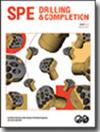Polyoxyethylene Quaternary Ammonium Gemini Surfactants as a Completion Fluid Additive to Mitigate Formation Damage
IF 1.2
4区 工程技术
Q3 ENGINEERING, PETROLEUM
引用次数: 12
Abstract
During well completion operations, the wells are killed with specific fluids to control the well. These fluids can invade and damage the formation because of fluid/rock interactions. Fluids such as fresh water, brines, and weighted fluids (e.g., barite weighted, calcite weighted, and bentonite weighted) are used to control the formations during completion operations. These fluids can invade and interact with clays and damage the formation. In addition, these fluids may alter the near-wellbore wettability and make them more oil-wet, thereby affecting the production from these formations. In this work, polyoxyethylene quaternary ammonium gemini surfactants with different types of spacers are proposed as clay swelling additives in completion fluids to mitigate the formation damage in unconventional reservoirs. Adding the new surfactants will maintain the in-situ permeability and avoid the formation damage. The novel gemini surfactants are tested on unconventional tight sandstone formation enriched with high clay content to mitigate the formation damage during well completion. The process involved a complete stabilization of clays using gemini surfactants added in deionized water (DW). Coreflooding experiments were carried out on Scioto sandstone rock samples with an average porosity of 15.6% and average absolute permeability of 0.25 md. Several coreflooding experiments were carried out with different fluids, such as potassium chloride (KCl), sodium chloride (NaCl), and different classes of gemini surfactants. Coreflooding experiments were designed in a way that the cores were preflushed with the subjected fluid and then post-flooded with DW. Results showed that the cores saturated with KCl and NaCl solutions lost permeability significantly when flooded with water while gemini surfactant solutions maintained the same permeability even after being treated with DW. Conditioning with the KCl solution resulted in a 38% reduction of permeability and that with NaCl solution resulted in an 80% reduction of permeability when treated with DW. No significant change of permeability was found for the case of gemini surfactants. This indicates that the synthesized surfactants can be used for well completion operation without any side effects.聚氧化乙烯季铵Gemini表面活性剂作为完井液添加剂减轻地层损害
在完井作业期间,用特定的流体压井以控制油井。由于流体/岩石的相互作用,这些流体可能侵入并损坏地层。完井作业期间,使用淡水、盐水和加重流体(如重晶石加重、方解石加重和膨润土加重)等流体控制地层。这些流体可以侵入粘土并与粘土相互作用,破坏地层。此外,这些流体可能会改变近井润湿性,使其更具油湿性,从而影响这些地层的生产。在这项工作中,提出了具有不同类型间隔层的聚氧乙烯季铵双子表面活性剂作为完井液中的粘土膨胀添加剂,以减轻非常规储层的地层损害。添加新的表面活性剂可以保持原位渗透率,避免地层损害。新型双子表面活性剂在富含高粘土的非常规致密砂岩地层上进行了测试,以减轻完井过程中对地层的损害。该过程涉及使用添加在去离子水中的双子表面活性剂对粘土进行完全稳定。对平均孔隙度为15.6%、平均绝对渗透率为0.25md的Scioto砂岩样品进行了岩心驱替实验。用不同的流体,如氯化钾(KCl)、氯化钠(NaCl)和不同类别的双子表面活性剂进行了多次岩心驱替试验。岩心驱替实验的设计方式是用受试流体对岩心进行预驱替,然后用DW进行后驱替。结果表明,KCl和NaCl溶液饱和的岩心在注水时渗透率显著降低,而gemini表面活性剂溶液即使在DW处理后仍保持相同的渗透率。当用DW处理时,用KCl溶液处理导致渗透率降低38%,而用NaCl溶液处理导致磁导率降低80%。在双子表面活性剂的情况下,没有发现渗透率的显著变化。这表明,合成的表面活性剂可以用于完井作业,没有任何副作用。
本文章由计算机程序翻译,如有差异,请以英文原文为准。
求助全文
约1分钟内获得全文
求助全文
来源期刊

SPE Drilling & Completion
工程技术-工程:石油
CiteScore
4.20
自引率
7.10%
发文量
29
审稿时长
6-12 weeks
期刊介绍:
Covers horizontal and directional drilling, drilling fluids, bit technology, sand control, perforating, cementing, well control, completions and drilling operations.
 求助内容:
求助内容: 应助结果提醒方式:
应助结果提醒方式:


